Three-piece ensemble project:
1. Oversize dancing sleeves with oversize high sheer neck top.
2. Sheer overlayed cover dress.
3. Bottom pins dress.
Project Views
- Front
- Side
- Back
- Top
- Sheer Layer
- Bottom Dress
Wearable Views
Process
For the process, I made a smaller version of it on the mannequin that we made in class with the real materials that I am going to use for the dress. In the process of making it, I directly drew the pattern on the fabric that I was using for my piece and cut it out. It was more convenient for me to draw on the fabric and cut it since I know the shapes of clothing that I wanted to do. While constructing the piece, I started from the basic then to the details. I did the top, the basic of the dress and then the overlayed sheer cover dress on top.
Reflection
First, for this project, my original idea was to combine the traditional dress from Han dynasty with the modern linen suit. The purpose was to create something feminine but shows the bold and strong side of it. Since seminar and studio are correlated together, the relationship between my seminar research paper and my studio piece are all related to appropriation; which is also our studio assignment’s main point, where we adapt from two archive pictures and create our own design.
The function for my piece is a formal dress for formal events, however, if you can wear the upper and bottom piece separately with other garments and it will be cable for informal events as well; even for daily wear as a fashion item. The main parts of the two archive photos that I have adapted and changed/transformed are the sleeves, dress, and vest. Also, the materials that I have adapted to the base of my dress and top is the fabric for suits usually, which are linen and cotton; also it has stripes pattern on it. This fabric will be my main and base material for my top and dress. More so, you can wear this dress in 2 ways, one putting the sheer outside and cover it and the other way is to put the sheer inside the pin dress to give it a puffy effect which embraces the linen pin dress.
Originally from the archive photos, the traditional dress for female from the Han dynasty has big wide-open long sleeves, which covers your whole arm and the vest was worn from the left side, then overlaps the right side of the upper piece. Moreover, the dress is quite long to the bottom, where it covers all your legs and there is another layer which looks like a corset, but it is located around the waist. For me, what I have changed is to make the vest into a more modern and exaggerated, where I have redesigned it to an oversized high neck collar by using organza and making the sleeves still oversized but made the upper arm part tighter. Then it opens below at the end of the sleeves with golden and black fabric tag line on each side of the sleeves.
Moving on, to the bottom dress, there are two layers. One is the sheer cover dress, where I also used organza and sewed the top sides in a pleated way, which makes it feminine. It was developed and extended from the corset of the Han dynasty dress. When you lift the sheer cover dress, inside, the base dress is made from the suite material, cotton fabric with line pattern. After, I have attached the huge metallic pins on the base dress in diagonal patterns. The pins here stands for armor and protection, which adds some rough texture to the whole dress.
Furthermore, during the process of making the pieces, I changed the idea of putting abstract shapes at the back of the upper top because I want to maintain minimalism throughout my pieces. Reflecting back, what I have learned throughout sewing and reconstructing the garment was the process of making the pattern and achieving your own design to successful of making it happen. Making the pieces, you have to think a lot of how to make the garment work and also see if the textile gives the visual effect that you wanted. I think what I have learned from myself through this project is that I like to draw the pattern directly on the fabric if I know the pattern well. This was more productive for me to make the pieces. As an improvement, I would make the patterns on the tracing paper, therefore in future, I am more able to recreate it and maybe use the pattern again for future garments. This was the main factor that I want to improve and learn for future projects; something to definitely do in future garment making.





















